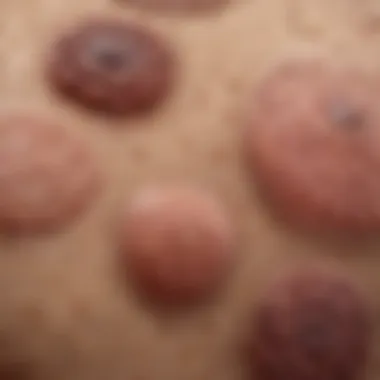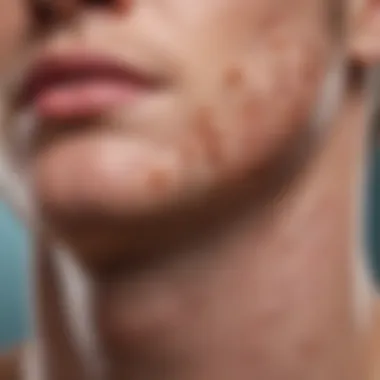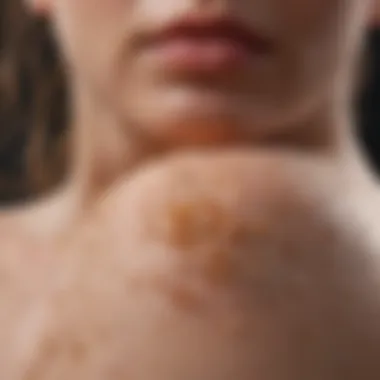Understanding Pruritic Rashes: Causes and Treatments


Intro
Pruritic rashes are a common dermatological concern, often causing significant discomfort and distress for those affected. Understanding these rashes requires more than just identifying them; it necessitates a comprehensive analysis of their causes, mechanisms, and potential treatments. This article endeavors to provide an in-depth examination of pruritic rashes, uncovering the complexities underlying this widespread issue.
Article Overview
This section aims to encapsulate the essence of the research conducted on pruritic rashes, providing readers with a clear framework for the findings discussed throughout the article.
Summary of Key Findings
Pruritic rashes can arise from various underlying factors, including allergic reactions, infections, and systemic diseases. These rashes may vary significantly in presentation and etiology, necessitating a nuanced understanding for effective diagnosis and treatment. Key findings of this research indicate:
- The importance of differentiating between types of pruritic rashes.
- The physiological mechanisms involved in the itch response.
- The varied treatment options available based on the underlying cause.
Recent studies underscore that not all rashes with itching are the same, highlighting the need for healthcare professionals to adopt a tailored approach.
Research Objectives
The primary objectives of this research are to:
- Define pruritic rashes and their common characteristics.
- Explore the physiological mechanisms contributing to pruritus.
- Analyze various causes, including dermatological and systemic conditions.
- Investigate effective treatment strategies that cater to individual needs.
By delving into these objectives, the aim is to equip healthcare professionals and interested readers with a deeper understanding of pruritic rashes.
Key Results and Discussions
Main Findings
The findings illustrate that pruritic rashes are not a homogeneous category but encompass a range of conditions from eczema to urticaria and even systemic diseases like liver dysfunction. Each of these conditions presents unique features that require specific management strategies.
Implications of Findings
Understanding the nuances of pruritic rashes can significantly impact patient care. Accurate diagnosis allows for appropriate treatment, which can alleviate symptoms and improve the quality of life for patients. Additionally, education around these rashes can empower individuals to seek medical help sooner, which is crucial for conditions that may require immediate intervention.
Defining Pruritic Rash
Understanding the concept of pruritic rash is vital for both healthcare professionals and those experiencing skin issues. A pruritic rash is characterized primarily by an itch or discomfort, which may arise due to various factors. These can include allergic responses, infections, or underlying skin conditions. The itch associated with a pruritic rash often serves as a significant indicator in diagnosing not just skin disorders but systemic issues as well. Recognizing a pruritic rash enables practitioners to formulate effective treatment plans, addressing both the symptoms and the root causes.
Characteristics of Pruritic Rashes
Pruritic rashes exhibit specific features that distinguish them from other types of rashes. The most notable characteristic is the intense itching which, in many cases, leads to scratching and can exacerbate the condition. Common characteristics include:
- Location: Pruritic rashes can occur on any part of the body, but specific conditions may target certain areas more frequently.
- Appearance: These rashes may present as red bumps, blisters, or even dry patches. The visual aspect can vary based on the underlying cause.
- Duration: The timeline of a pruritic rash can also vary; some may be acute and resolve quickly, while others may persist, indicating a chronic issue.
These elements are crucial for any healthcare provider in establishing a potential diagnosis and determining appropriate treatments.
Distinction from Non-pruritic Rashes
It is essential to differentiate pruritic rashes from non-pruritic ones. Non-pruritic rashes do not involve itchiness and can occur due to various factors such as irritant contact dermatitis or certain infections. Here are distinctive points to consider:
- Presence of Itching: The most fundamental difference is the presence of itching. If a rash causes no itch, it is typically classified as non-pruritic.
- Underlying Causes: Non-pruritic rashes might be pain-related or purely visual disturbances, often linked to skin conditions such as psoriasis or eczema that do not primarily cause itching.
- Treatment Approaches: Treatment differs significantly between these rashes. Pruritic rashes often require antihistamines or topical corticosteroids, while non-pruritic rashes may need anti-inflammatory treatments.
In summary, defining pruritic rashes and understanding their characteristics are essential steps in the broader analysis of skin health. Recognizing the differences between pruritic and non-pruritic rashes contributes to better diagnostic accuracy and ultimately more effective treatment plans.
Common Causes of Pruritic Rashes
Understanding the common causes of pruritic rashes is fundamental for effective diagnosis and treatment. This section delves into the various triggers that can lead to intense itching and skin irritation. Recognizing these causes enables healthcare professionals and patients alike to address the root of the problem rather than merely alleviating symptoms. Awareness of these elements can significantly improve the management strategies for individuals suffering from such rashes.
Allergic Reactions
Allergic reactions can manifest as pruritic rashes due to the body's immune response to specific allergens. Common allergens include certain foods, medications, and environmental substances such as pollen or pet dander. Once the skin comes into contact with an allergen, the immune system may recognize it as a threat, resulting in histamine release. This process leads to itchy red spots and swelling.


Effective management often involves identifying and avoiding these triggers. Patch testing can be an essential diagnostic tool. Patients may benefit from keeping a food and exposure diary to recognize patterns related to flare-ups.
Infections and Infestations
Infections, whether bacterial, viral, or fungal, frequently lead to pruritic rashes. Conditions like chickenpox or shingles, caused by the varicella-zoster virus, manifest with rashes that are often intensely itchy. Bacterial infections, like impetigo, generate blisters that may burst and ooze, leading to itching.
In addition, infestations by parasites such as scabies or lice can provoke severe itching. These infestations should be promptly treated with topical or oral antiparasitic medications to relieve symptoms and prevent further skin damage. Recognizing the signs of these infections is critical for timely treatment.
Dermatological Conditions
Various dermatological conditions prominently feature pruritic rashes. For instance, eczema often leads to dry and itchy skin, creating a cycle of scratching and further irritation. Psoriasis is another condition characterized by red, scaly patches on the skin and can also elicit intense itching.
Chronic dermatological issues like dermatitis herpetiformis, linked to gluten sensitivity, should also be considered. These conditions often require specific treatments, such as topical steroids or immunomodulators, tailored to reduce inflammation and control itching.
Systemic Diseases
Some systemic diseases affect the skin and can result in pruritic rashes. Conditions like liver disease may present with generalized itching due to the accumulation of bile salts in the bloodstream. Similarly, renal failure can lead to uremic pruritus, causing widespread itching without a visible rash.
These systemic associations must not be overlooked, as they can indicate underlying, serious health issues. Thus, a thorough medical evaluation is crucial in these scenarios, as it guides appropriate treatment and management.
Environmental Factors
Environmental factors can also be a considerable cause of pruritic rashes. Climate, humidity levels, and exposure to certain chemicals can exacerbate skin irritation. For example, prolonged exposure to chlorine from swimming pools or soaps containing harsh detergents may lead to rashes.
It is important to establish a proper skin care routine that incorporates moisturizers to mitigate dryness. Minimizing exposure to known irritants can also effectively manage symptoms in sensitive individuals. Understanding these environmental influences can help in crafting personalized skincare strategies that will aid in reducing irritation and preventing flare-ups.
"Recognizing and understanding the diverse causes of pruritic rashes can significantly enhance treatment outcomes and improve the quality of life for affected individuals."
Through careful consideration of these factors, it is possible to adopt a more comprehensive approach to managing pruritic rashes, which influences both immediate care and long-term health strategies.
Pathophysiology of Pruritus
Understanding the pathophysiology of pruritus is key to grasping why itchy rashes occur. It links the clinical presentation of pruritic rashes to underlying biological mechanisms. Insight into these mechanisms aids in developing effective treatment options. This lays the groundwork for effective management strategies that directly address symptoms and underlying causes.
Neurophysiological Mechanisms
Pruritus results from complex interactions within the nervous system. Sensory neurons play a crucial role in transmitting itch signals from the skin to the spinal cord and brain. These neurons are typically activated by irritants or inflammatory mediators. The primary mediators involved include histamines, cytokines, and neuropeptides. The transmission pathway involves several key structures:
- Afferent sensory fibers: These are nerve fibers that carry signals from the skin to the central nervous system.
- Dorsal horn of the spinal cord: This structure processes the incoming signals and modulates the sensation of itch.
- Higher brain centers: These regions interpret the signals, leading to the conscious perception of pruritus.
Moreover, pruritus can be categorized into two types based on origin: acute and chronic. Acute pruritus typically arises from inflammatory skin conditions like eczema or contact dermatitis. Chronic pruritus can stem from systemic issues, demanding a broader assessment.
Immune Response in Skin
The skin acts as the first line of defense against external aggressors. This barrier contains immune cells that play a role in the onset of pruritus. When an allergen or irritant contacts the skin, immune cells, such as T cells and mast cells, become activated. This prompts the release of various mediators that contribute to inflammation and the itch sensation.
- Mast cells: These cells release histamines which exacerbate the itch and lead to local inflammation.
- T helper cells: Particularly T cells, contribute to the allergic response by producing cytokines.
- Cytokines: These signaling proteins can enhance the activation of sensory neurons, leading to further pruritus.
In summary, both neurophysiological mechanisms and immune responses significantly contribute to the development of pruritic rashes. Understanding these processes is essential for accurate diagnosis and effective treatment.
Diagnosis of Pruritic Rashes
Diagnosis of pruritic rashes is a critical aspect of dermatological practice. Correctly identifying rashes can lead to effective treatment options and prevent complications. There is often a range of conditions that can lead to itchy skin, thus necessitating a methodical approach. Understanding the clinical history, performing a thorough examination, and utilizing diagnostic tests are essential steps in discerning the underlying cause of pruritus.
Clinical History and Examination
Gathering a clinical history is fundamental for diagnosing pruritic rashes. The physician will ask about the onset of the rash, its duration, and if there have been any recent exposures to allergens. Patients should describe any accompanying symptoms, such as fever or fatigue, which could suggest systemic involvement. A physical examination will reveal the rash's characteristics, such as its type, distribution, and whether there are any associated secondary changes like excoriations or crusting.
The significance of a focused patient interview cannot be overlooked. Common questions may include:
- Have you changed any skincare products recently?
- Are there any new medications in your routine?
- Do you have a history of allergies or skin conditions?


This process helps in establishing a potential link between the patient's history and the rash.
Diagnostic Tests and Procedures
In certain cases, additional diagnostic tests may be necessary to confirm the diagnosis. These tests can range from simple skin examinations to more advanced procedures. Common diagnostic tests include:
- Skin Scraping: This method helps to identify fungal infections by examining skin cells under a microscope.
- Patch Testing: Useful for diagnosing allergic contact dermatitis by identifying specific allergens.
- Biopsy: Skin biopsies can provide crucial information when the diagnosis is unclear. A sample is taken from the affected area and examined histologically.
- Blood Tests: These can help in diagnosing systemic diseases or infections that may cause pruritus.
Diagnostic tests are supportive and should be guided by clinical findings. Each test has its benefits and limitations.
Differential Diagnosis
Differential diagnosis is an important part of evaluating pruritic rashes. A variety of conditions may present with similar symptoms. Thus, a clear differentiation is necessary.
Conditions that may need to be considered include:
- Eczema: Often associated with dryness and inflammation.
- Psoriasis: Characterized by silvery plaques and frequent involvement of elbows and knees.
- Scabies: Caused by a mite infestation, this condition leads to intense itching and burrows in the skin.
- Urticaria: Also known as hives, can be triggered by allergens and presents as raised, itchy welts.
Physicians must compare the clinical features and history of each condition to arrive at an accurate diagnosis.
Accurate diagnosis plays a key role in determining the appropriate management strategy, which is crucial for patient comfort and long-term outcomes.
Management and Treatment
The management and treatment of pruritic rashes are essential components of dermatological care. A pruritic rash can be uncomfortable and distressing. Effective treatment not only alleviates the symptoms but also addresses the underlying causes of the rash. Proper management can prevent the rash from becoming chronic or leading to further complications. Each treatment strategy has its distinct applications, benefits, and considerations, which must be tailored to the individual's specific condition and needs.
Topical Treatments
Topical treatments are often the first line of defense against pruritic rashes. These formulations are directly applied to the skin and provide localized relief. Common examples include corticosteroids, antihistamines, and moisturizers. Corticosteroids help reduce inflammation and itching. Antihistamines counteract allergic reactions, while moisturizers can restore hydration and barrier function.
- Corticosteroids: These can vary in strength. Mild ones are suitable for delicate areas, while stronger variants are employed in more severe cases. Short-term use is generally safe, but long-term application can lead to skin thinning.
- Antihistamines: These are used for allergic responses, providing relief from intense itching. They can be found in both topical and oral forms.
- Moisturizers: Maintaining skin hydration is crucial in managing pruritus. Regular application can prevent the skin from becoming dry and cracked, which often exacerbates the itching sensation.
Oral Medications
Oral medications can be necessary when topical treatments do not provide sufficient relief. These medications work systemically to reduce itchiness and inflammation. Antihistamines, corticosteroids, and immunosuppressants are common options.
- Antihistamines: Systemic antihistamines can have a sedative effect, helping patients sleep better when itching is severe at night.
- Corticosteroids: In more serious cases, oral corticosteroids may be prescribed for a short duration to control flare-ups effectively. Care is needed to monitor potential side effects.
- Immunosuppressants: Drugs like cyclosporine or methotrexate may be considered for persistent pruritis linked to autoimmune conditions. Their use must be carefully monitored due to potential impacts on overall health.
Lifestyle Modifications
Lifestyle modifications play a pivotal role in managing pruritic rashes effectively. These changes can minimize triggers and improve skin health.
- Identify Triggers: Keeping a diary to track food intake, skincare products, and environmental exposures can help identify potential allergens.
- Maintain a Gentle Skin Care Routine: Use fragrance-free products and avoid harsh soaps, which can irritate the skin further.
- Stay Hydrated: Adequate water intake supports skin health and may mitigate dryness.
- Wear Loose Clothing: Tight clothing can irritate the skin and worsen itching. Opting for loose, breathable fabrics can help alleviate discomfort.
- Avoid Hot Showers: Long, hot showers can worsen dryness. Instead, opt for lukewarm water and limit shower times.
"Understanding and adjusting lifestyle factors significantly contribute to the overall management of pruritic rashes."
Combining these treatment and management strategies can lead to more effective relief from pruritic rashes. Regular consultations with a healthcare professional are vital to ensure that the management plan is tailored and adjusted as necessary.
Complications of Untreated Pruritic Rashes
The complications arising from untreated pruritic rashes are crucial in understanding the overall impact of these conditions. Ignoring symptoms can lead to serious health issues. Awareness about the potential consequences empowers patients and healthcare providers to take timely action. Therefore, recognizing and addressing pruritic rashes can significantly improve quality of life.
Secondary Infections
One of the most common complications involves secondary infections. When an individual has a pruritic rash, the urge to scratch the affected area often leads to skin breaks. Bacteria can then enter through these openings, resulting in infections such as folliculitis or cellulitis. For example, Staphylococcus aureus is a frequent offender.
To minimize risk, patients should keep the affected areas clean and refrain from scratching when possible. Infected skin may present with increased redness, warmth, or even pus. If these signs occur, medical attention is necessary to address the infection with appropriate antibiotics.
Skin Damage and Scarring
Untreated pruritic rashes can result in significant skin damage. Prolonged scratching not only aggravates the original condition but can also cause lichenification, which is thickening of the skin due to repeated trauma. This can lead to unsightly scars or discoloration.


In severe cases, chronic scratching may result in permanent changes to the skin's texture. Treatment might become more complicated when irreversible damage occurs, necessitating advanced dermatological interventions. Protecting the skin with moisturizers and topical treatments may help reduce the risk of chronic damage.
Psychological Impact
The psychological aspect of living with untreated pruritic rashes is often underestimated. Persistent itching can lead to sleep disturbances, irritability, and even anxiety. The visible nature of rashes may cause social withdrawal or embarrassment in individuals, further impacting their mental health.
Health professionals must consider these psychological effects when treating pruritic rashes. Interventions may need to include counseling or support groups. Effective management of the physical aspects can improve the overall well-being of the patient.
It's important to treat pruritic rashes promptly to avoid complications that may affect both physical and mental health.
In summary, the complications of untreated pruritic rashes highlight the necessity for timely medical intervention. From secondary infections to lasting skin damage and psychological impacts, the consequences can be extensive.
Vigilance in monitoring rashes is essential in minimizing these risks.
Preventive Measures
Preventive measures are critical in the overall management of pruritic rashes. Addressing these issues before they manifest can significantly improve a person's quality of life. Understanding how to avoid triggers and implementing effective skin care routines are vital components of prevention.
Identifying Triggers
Identifying triggers is essential in preventing pruritic rashes from occurring or worsening. Triggers can vary greatly between individuals, which necessitates a personalized approach. These triggers may include:
- Environmental Factors: Pollen, dust mites, and pet dander can all provoke allergic reactions. Monitoring pollen counts and minimizing exposure during high pollen seasons can be beneficial.
- Products and Materials: Certain soaps, detergents, or fabrics may cause skin irritations. Conducting patch tests before using new products can help identify potential allergens.
- Food Sensitivities: Some individuals may experience skin reactions due to food allergies such as nuts, shellfish, or dairy. Keeping a food diary can assist in recognizing any correlations.
- Stress: Emotional factors can impact skin health. Techniques like mindfulness and relaxation strategies may help reduce skin flare-ups associated with stress.
By identifying these triggers, individuals can make informed decisions about their environments and lifestyles, ultimately minimizing the risk of pruritic rashes.
Skin Care Routines
A proper skin care routine can serve as a foundation for preventing pruritic rashes. It is essential to use products that are gentle and suitable for sensitive skin. Here are some elements to consider when establishing effective skin care routines:
- Mild Cleansers: Opt for gentle, fragrance-free cleansers. This helps remove dirt without stripping natural oils.
- Moisturization: Applying moisturizers regularly is key. Look for formulations containing ceramides or hyaluronic acid, which help to retain skin hydration.
- Sunscreen: Protecting the skin from harmful UV rays is important. Choose a sunscreen labeled as non-comedogenic to avoid clogging pores.
- Avoid Hot Water: Hot water can increase skin dryness. It is advisable to use lukewarm water during showers and baths.
- Humidifiers: Using a humidifier in dry environments can help maintain moisture levels in the air, keeping skin hydrated.
Maintaining a consistent skin care routine tailored to individual needs can significantly reduce the occurrence and severity of pruritic rashes. In conjunction with identifying triggers, these preventive measures can empower individuals to manage their skin health effectively.
When to Seek Medical Attention
Understanding when to seek medical attention for pruritic rashes is crucial. Not all cases of itching require professional intervention. However, recognizing the signs that indicate a need for medical advice can prevent complications and ensure proper treatment. The importance of this topic lies in its ability to guide individuals in making informed decisions about their health.
Signs of Severe Reactions
Some skin reactions may escalate quickly, leading to serious health issues. Look for the following signs:
- Widespread rash: If the rash covers a large area of the body.
- Difficulty breathing: This can indicate an anaphylactic reaction.
- Swelling: Especially in the face, lips, or throat.
- High fever: Fever above 101°F (38.3°C) can suggest an infection.
- Blistering or peeling skin: These symptoms may indicate a severe reaction such as Steven-Johnson syndrome.
If any of these symptoms occur, it is imperative to seek medical care immediately.
"Prompt attention to severe reactions can save lives and minimize long-term health issues."
Progression and Duration of Symptoms
The duration and progression of symptoms are significant factors in deciding whether to seek medical help. Itching, redness, or swelling that persists beyond a few days warrants further evaluation. Consider the following points:
- Duration: Rashes that last more than a week should be assessed by a healthcare professional.
- Change in symptoms: If the rash worsens or new symptoms develop, medical review is important.
- History of underlying conditions: Patients with a history of skin conditions or other systemic diseases must be vigilant about new rashes.
Recognizing these elements can aid in early detection and treatment of potentially serious issues related to pruritic rashes.
The End
In summation, the exploration of pruritic rashes encompasses numerous essential aspects crucial for a comprehensive understanding of dermatological health. Pruritic rashes are not merely skin irritations but are manifestations of underlying health issues that require appropriate attention, diagnosis, and intervention. It is vital to recognize the distinctive features and potential triggers of these rashes for effective management. The article emphasizes the need for meticulous clinical evaluation, as the causes can range from allergic reactions to systemic diseases or dermatological conditions.
Moreover, recognizing the potential complications of untreated pruritic rashes—a topic discussed extensively in previous sections—propels healthcare professionals and patients alike to prioritize timely medical consultation. Secondary infections, skin damage, and psychological impacts can arise if pruritus is left unchecked. Therefore, this literature not only serves as an academic resource but also highlights practical implications for both practitioners and individuals.
The discussion on preventive measures further enriches the dialogue around pruritic rashes. By identifying triggers and adhering to proper skin care routines, individuals can potentially alleviate symptoms and improve their quality of life. The synthesis of information presented in this article creates a roadmap for understanding, managing, and preventing pruritic rashes effectively.
Recapitulation of Key Points
- Definition: Pruritic rashes are characterized by itchiness and can arise from various causes.
- Causes: A wide array of factors, including allergies, infections, dermatological conditions, systemic diseases, and environmental influences contribute to their occurrence.
- Diagnosis: Accurate diagnosis involves thorough clinical history, examination, and potentially diagnostic tests to distinguish the type of rash.
- Management: Treatment can include topical treatments, oral medications, and lifestyle modifications tailored to individual needs.
- Complications: Complications such as secondary infections or psychological effects are significant if not addressed.
- Preventive Measures: Identifying triggers and maintaining a proper skincare regime can help mitigate the occurrence and severity of pruritic rashes.
Understanding these elements allows healthcare professionals and patients to approach pruritic rashes with a well-informed perspective, promoting better health outcomes.







